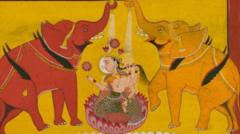This week, the British Museum in London launched an intriguing exhibition titled "Ancient India: Living Traditions," celebrating the diverse journey of spiritual art from the Indian subcontinent. Featuring 189 exceptional artifacts spanning two millennia, the exhibit invites visitors to discover ancient sculptures, paintings, and manuscripts that detail the transformative progression of India's religious visual culture.
Key transformations took place between 200 BC and AD 600, a pivotal era which saw sacred imagery evolve from abstract to more relatable human forms. Art representing divine entities, including revered figures in Hinduism, Buddhism, and Jainism, illustrates this notable shift. According to Sushma Jansari, the exhibition's curator, this journey is compelling, as contemporary perceptions of divine spirits in these faiths are so tightly intertwined with human-like representations.
The exhibit is organized into five thematic sections, beginning with nature spirits and continuing to focus on the specific influences of the Hindu, Buddhist, and Jain traditions. It culminates with the influence of Indian art and faiths on other cultures, including those in Cambodia and China. Among the highlights is a striking two-sided sandstone panel tracing the artistic representation of the Buddha, illustrating the transition from a symbolic portrayal, indicated by an empty throne and footprints, to a robust human form adorned with intricate details.
The Hindu section showcases a bronze statue that encapsulates the gradual evolution of sacred imagery, merging elements of nature spirits with traditional goddess depictions. Additionally, Jain artistic expressions concentrate on the revered tirthankaras, the 24 enlightened beings integral to the faith, with artifacts dating back 2,000 years embodying the tradition's artistic roots.
Unique to this exhibition, it is the first comprehensive exploration of art across these three significant religious practices collectively, rather than in isolation. It emphasizes the shared techniques and themes present in relics produced in ancient workshops, particularly in the city of Mathura.
Beyond physical exhibits, the exhibition offers an immersive experience; by integrating natural scents, sounds, and colors, it aims to create an atmosphere that reflects the tranquility and vibrancy of living religious spaces. Interactive elements, such as films highlighting contemporary practitioners of these faiths, reinforce the notion that the artistic and spiritual traditions explored are not confined to the past but continue to resonate with millions today.
"Ancient India: Living Traditions" is on display at the British Museum from May 22 to October 19, drawing from extensive collections both within the museum and from numerous international lenders.
Key transformations took place between 200 BC and AD 600, a pivotal era which saw sacred imagery evolve from abstract to more relatable human forms. Art representing divine entities, including revered figures in Hinduism, Buddhism, and Jainism, illustrates this notable shift. According to Sushma Jansari, the exhibition's curator, this journey is compelling, as contemporary perceptions of divine spirits in these faiths are so tightly intertwined with human-like representations.
The exhibit is organized into five thematic sections, beginning with nature spirits and continuing to focus on the specific influences of the Hindu, Buddhist, and Jain traditions. It culminates with the influence of Indian art and faiths on other cultures, including those in Cambodia and China. Among the highlights is a striking two-sided sandstone panel tracing the artistic representation of the Buddha, illustrating the transition from a symbolic portrayal, indicated by an empty throne and footprints, to a robust human form adorned with intricate details.
The Hindu section showcases a bronze statue that encapsulates the gradual evolution of sacred imagery, merging elements of nature spirits with traditional goddess depictions. Additionally, Jain artistic expressions concentrate on the revered tirthankaras, the 24 enlightened beings integral to the faith, with artifacts dating back 2,000 years embodying the tradition's artistic roots.
Unique to this exhibition, it is the first comprehensive exploration of art across these three significant religious practices collectively, rather than in isolation. It emphasizes the shared techniques and themes present in relics produced in ancient workshops, particularly in the city of Mathura.
Beyond physical exhibits, the exhibition offers an immersive experience; by integrating natural scents, sounds, and colors, it aims to create an atmosphere that reflects the tranquility and vibrancy of living religious spaces. Interactive elements, such as films highlighting contemporary practitioners of these faiths, reinforce the notion that the artistic and spiritual traditions explored are not confined to the past but continue to resonate with millions today.
"Ancient India: Living Traditions" is on display at the British Museum from May 22 to October 19, drawing from extensive collections both within the museum and from numerous international lenders.


















